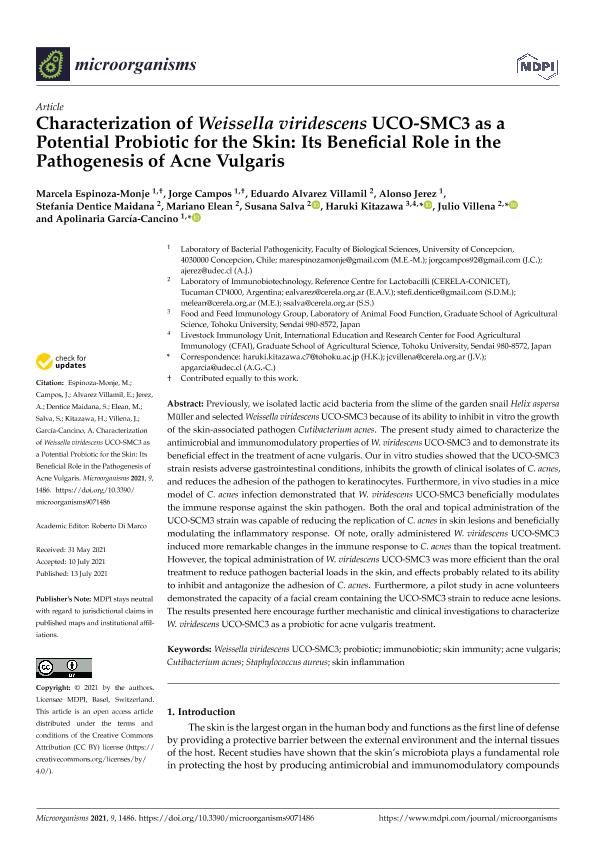Mostrar el registro sencillo del ítem
dc.contributor.author
Espinoza Monje, Marcela
dc.contributor.author
Campos, Jorge
dc.contributor.author
Alvarez Villamil, Eduardo Gaspar

dc.contributor.author
Jerez, Alonso
dc.contributor.author
Dentice Maidana, Stefania

dc.contributor.author
Elean, Mariano Daniel

dc.contributor.author
Salva, Maria Susana

dc.contributor.author
Kitazawa, Haruki

dc.contributor.author
Villena, Julio Cesar

dc.contributor.author
García Cancino, Apolinaria
dc.date.available
2022-06-16T15:43:05Z
dc.date.issued
2021-07
dc.identifier.citation
Espinoza Monje, Marcela; Campos, Jorge; Alvarez Villamil, Eduardo Gaspar; Jerez, Alonso; Dentice Maidana, Stefania; et al.; Characterization of weissella viridescens uco-smc3 as a potential probiotic for the skin: Its beneficial role in the pathogenesis of acne vulgaris; MDPI AG; Microorganisms; 9; 7; 7-2021; 1-24
dc.identifier.issn
2076-2607
dc.identifier.uri
http://hdl.handle.net/11336/159966
dc.description.abstract
Previously, we isolated lactic acid bacteria from the slime of the garden snail Helix aspersa Müller and selected Weissella viridescens UCO-SMC3 because of its ability to inhibit in vitro the growth of the skin-associated pathogen Cutibacterium acnes. The present study aimed to characterize the antimicrobial and immunomodulatory properties of W. viridescens UCO-SMC3 and to demonstrate its beneficial effect in the treatment of acne vulgaris. Our in vitro studies showed that the UCO-SMC3 strain resists adverse gastrointestinal conditions, inhibits the growth of clinical isolates of C. acnes, and reduces the adhesion of the pathogen to keratinocytes. Furthermore, in vivo studies in a mice model of C. acnes infection demonstrated that W. viridescens UCO-SMC3 beneficially modulates the immune response against the skin pathogen. Both the oral and topical administration of the UCO-SCM3 strain was capable of reducing the replication of C. acnes in skin lesions and beneficially modulating the inflammatory response. Of note, orally administered W. viridescens UCO-SMC3 induced more remarkable changes in the immune response to C. acnes than the topical treatment. However, the topical administration of W. viridescens UCO-SMC3 was more efficient than the oral treatment to reduce pathogen bacterial loads in the skin, and effects probably related to its ability to inhibit and antagonize the adhesion of C. acnes. Furthermore, a pilot study in acne volunteers demonstrated the capacity of a facial cream containing the UCO-SMC3 strain to reduce acne lesions. The results presented here encourage further mechanistic and clinical investigations to characterize W. viridescens UCO-SMC3 as a probiotic for acne vulgaris treatment.
dc.format
application/pdf
dc.language.iso
eng
dc.publisher
MDPI AG
dc.rights
info:eu-repo/semantics/openAccess
dc.rights.uri
https://creativecommons.org/licenses/by-nc-sa/2.5/ar/
dc.subject
ACNE VULGARIS
dc.subject
CUTIBACTERIUM ACNES
dc.subject
IMMUNOBIOTIC
dc.subject
PROBIOTIC
dc.subject
SKIN IMMUNITY
dc.subject
SKIN INFLAMMATION
dc.subject
STAPHYLOCOCCUS AUREUS
dc.subject
WEISSELLA VIRIDESCENS UCO-SMC3
dc.subject.classification
Biología Celular, Microbiología

dc.subject.classification
Ciencias Biológicas

dc.subject.classification
CIENCIAS NATURALES Y EXACTAS

dc.title
Characterization of weissella viridescens uco-smc3 as a potential probiotic for the skin: Its beneficial role in the pathogenesis of acne vulgaris
dc.type
info:eu-repo/semantics/article
dc.type
info:ar-repo/semantics/artículo
dc.type
info:eu-repo/semantics/publishedVersion
dc.date.updated
2022-06-13T18:45:08Z
dc.journal.volume
9
dc.journal.number
7
dc.journal.pagination
1-24
dc.journal.pais
Suiza

dc.journal.ciudad
Berna
dc.description.fil
Fil: Espinoza Monje, Marcela. Universidad de Concepción; Chile
dc.description.fil
Fil: Campos, Jorge. Universidad de Concepción; Chile
dc.description.fil
Fil: Alvarez Villamil, Eduardo Gaspar. Consejo Nacional de Investigaciones Científicas y Técnicas. Centro Científico Tecnológico Conicet - Tucumán. Centro de Referencia para Lactobacilos; Argentina
dc.description.fil
Fil: Jerez, Alonso. Universidad de Concepción; Chile
dc.description.fil
Fil: Dentice Maidana, Stefania. Consejo Nacional de Investigaciones Científicas y Técnicas. Centro Científico Tecnológico Conicet - Tucumán. Centro de Referencia para Lactobacilos; Argentina. Universidad Nacional de Tucumán. Facultad de Bioquímica, Química y Farmacia. Instituto de Microbiología; Argentina
dc.description.fil
Fil: Elean, Mariano Daniel. Consejo Nacional de Investigaciones Científicas y Técnicas. Centro Científico Tecnológico Conicet - Tucumán. Centro de Referencia para Lactobacilos; Argentina
dc.description.fil
Fil: Salva, Maria Susana. Consejo Nacional de Investigaciones Científicas y Técnicas. Centro Científico Tecnológico Conicet - Tucumán. Centro de Referencia para Lactobacilos; Argentina
dc.description.fil
Fil: Kitazawa, Haruki. Tohoku University; Japón
dc.description.fil
Fil: Villena, Julio Cesar. Consejo Nacional de Investigaciones Científicas y Técnicas. Centro Científico Tecnológico Conicet - Tucumán. Centro de Referencia para Lactobacilos; Argentina
dc.description.fil
Fil: García Cancino, Apolinaria. Universidad de Concepción; Chile
dc.journal.title
Microorganisms
dc.relation.alternativeid
info:eu-repo/semantics/altIdentifier/doi/http://dx.doi.org/10.3390/microorganisms9071486
dc.relation.alternativeid
info:eu-repo/semantics/altIdentifier/url/https://www.mdpi.com/2076-2607/9/7/1486
Archivos asociados
